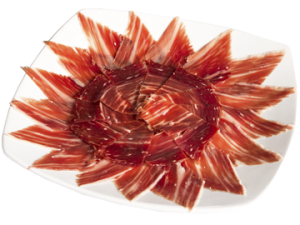
This image has format transparent PNG with resolution 300x225.
You can download this image in best resolution from this page and use it for design and web design.
Jamon PNG with transparent background you can download for free, just click on download button.
Jamon is the Spanish word for Ham. In English it refers to certain types of dry-cured ham from Spain. There are two primary labels for jamon: jamon iberico (ham from the Black Iberian pig), and jamon serrano (meaning ham from the sierra or mountain range), which includes most other varieties.
Jamon elaboration is similar to that of Portuguese presunto and to Italian prosciutto but it is typically cured for longer (up to 18 months).
Regionally; in Spain jamon is also known as pernil (in Aragon, Catalonia, Valencia, and other areas of Eastern Spain), xamon (in Galicia) and urdaiazpiko (in the Basque Country and Navarre).
Jamón is typically consumed in slices, either manually carved from a leg on a jamonero stand using a sharp thin slicing knife, or cut from the deboned meat with a rotatory cold-cut slicer. It's also regularly consumed in any shape in small portions.
As a product, Jamón is similar to Portuguese presunto and to Italian prosciutto, but the production differs by a longer curing phase (up to 18 months), giving it a dryer texture, deeper color and stronger flavour than the former.
A whole Jamón leg is considerably cheaper by weight than its sliced counterpart because it includes the bone and non-edible fat. Once the external fat layers are removed and the meat is exposed, though, the product must be consumed as soon as possible since a progressive drying and deteriorating process starts. This is not an issue for restaurateurs and retailers, since they go through product much faster than an individual. Home users will typically choose sliced product, be it freshly cut from a deli stand, commercially pre-packaged or vacuum preserved. Jamón is safe to consume for as long as is kept in its leg in a dry and cool environment and direct sunlight is avoided, but it must be kept refrigerated once cut away from the leg.
Jamón may also be smoked in some regions and it is consumed, mostly for personal use. This is common in the southern area of Castile and León as well as parts of Extremadura. Such a jamón has a harder texture and smoky-salty flavour.
Though widely available (even if on the expensive side) in Spain and accessible in some of the European Union, import duties and trade or food safety restrictions that apply to foreign meat products[9] in international markets may raise substantially the prices while creating a scarcity, often making jamón a prohibitively costly product to import and offer overseas.
There are two main commercial labels for jamón, based on the pig breed and protected designations:
Fresh hams are trimmed and cleaned, then stacked and covered with salt for about two weeks to draw off excess moisture and preserve the meat from spoiling. The salt is then washed off and the hams are hung to dry for about six months. Finally, the hams are hung in a cool, dry place for six to 18 months, depending on the climate, as well as the size and type of ham being cured. The drying sheds (secaderos) are usually built at higher elevations, which is why the ham is called "mountain ham".
In this page you can download free PNG images: Jamon PNG images free download